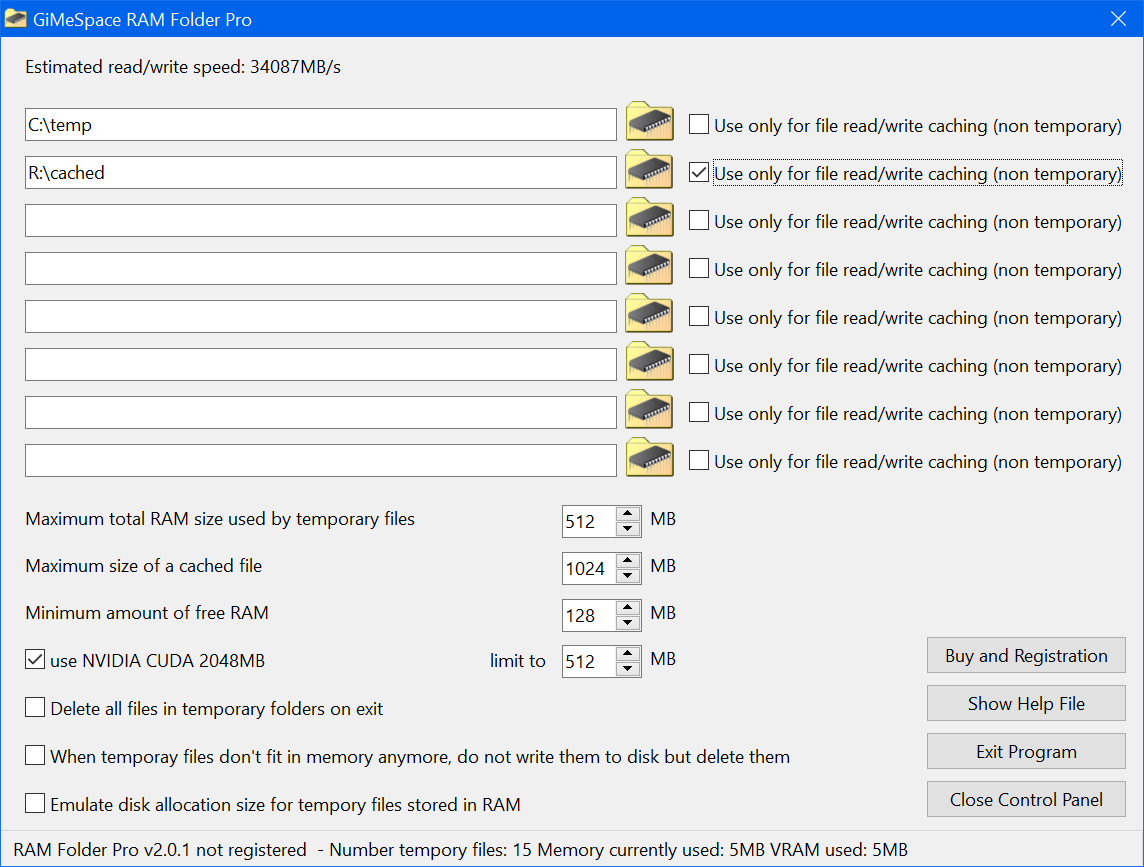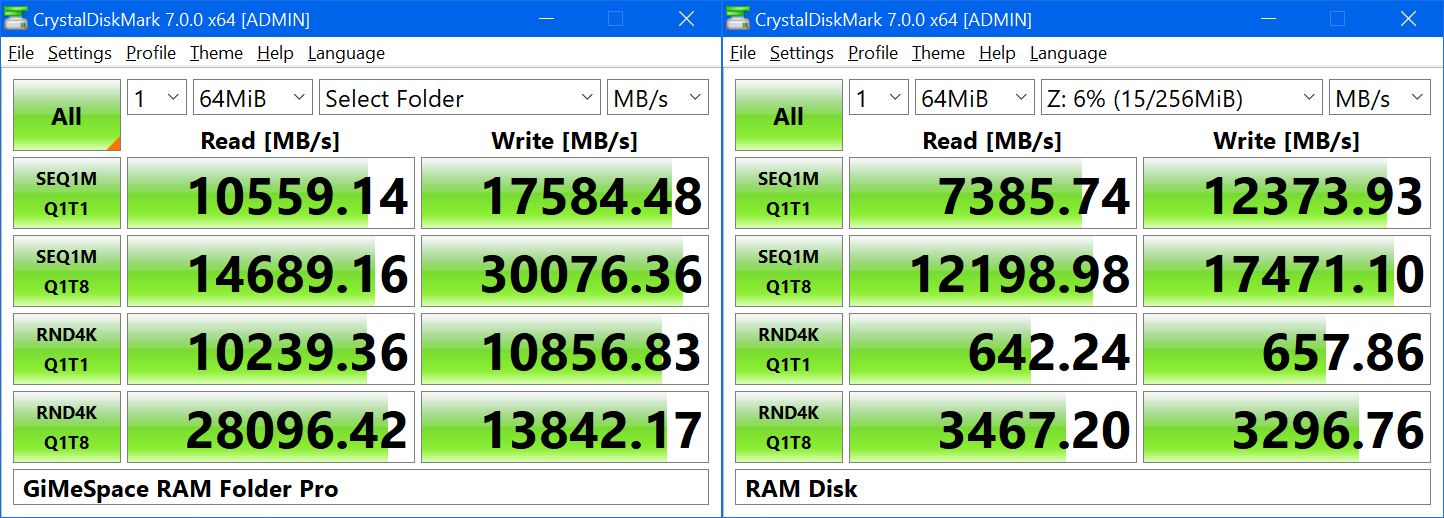![]() GiMeSpace RAM Folder Pro makes it possible to assign folders that will only store files in the RAM memory instead of on your disk as well as providing a safe write caching for file writes. So it combines the best of both RAM disk and disk caching programs but with minimal overhead making this program even faster than those programs.
GiMeSpace RAM Folder Pro makes it possible to assign folders that will only store files in the RAM memory instead of on your disk as well as providing a safe write caching for file writes. So it combines the best of both RAM disk and disk caching programs but with minimal overhead making this program even faster than those programs.
What is the use of this?
- The windows temporary folder is usually full of needless files that keep piling up wasting you disk space. This program can keep all of them in RAM and discard them when no longer needed.
- By assigning as specific folder as a RAM folder you get file access that is as fast as your RAM access which can greatly speedup certain programs including games. Because it has much smaller overhead, this program is even much faster than the fastest RAM disk programs. Tests show it is between 2x (sequential access) and 20x (random access) faster than tradition RAM Disks!
- Excess disk writes on a SSD disk can wear out the disk over time. This program can help you extend the life time of a SSD disk by avoiding disk writes.
- Some programs use your disk as external memory even if you have enough RAM available. Examples are audio/video editors and many other programs that use a lot of memory. This program will instead use your RAM and avoids needless disk access while at the same time speeding up these programs because RAM is much faster than even the fastest SSD.
- This program can even use the VRAM of your dedicated graphics card to store files making sure you use all the fast storage memory that is available in your system.
The Pro version has a special option to enable smart write caching on a folder. This means that files in those folders will be written to the disk once the program has finished with them. This is useful when you want to accelerate heavy file IO and avoid needless disk access. Windows read cache is already very good, but the native Windows write cache is very conservative, always trying to write data to files as soon as possible. Windows does this to make sure your files are always up to date and you will not likely lose any data in case of a crash. There are many disk caching programs that enable write caching which greatly reduces the number of writes to your disk meaning that your SSD is not wearing out that quickly and greatly speeding up your programs. But these programs have one danger: If a program or even Windows crashes, you lose the data in the cache and even disk corruption can occur. GiMeSpace RAM folder has a smarter way to do write caching: It never caches disk management writes or any system/kernel access. It only caches the files of your user programs. It caches the content of files until a program is completely done with it and then writes the whole file in one go to the disk. This way the chance that a file is corrupted is even lower then when you use the native Windows write caching because it ensures only the latest finalized version of the file is written to disk and not all the intermediary stages like what Windows is doing.
Version 2.2.x is now even faster than previous versions!
Download GiMeSpace RAM Folder Pro 2.3.1 and try for maximum 30 days for free without paying:

![]() GiMeSpace RAM Temp Folder is the Lite edition of this program. It is optimized for systems with very little memory in such a way that they can still enjoy the benefits of fast file access in the Temporary folder while avoiding needless disc access. It will only transform your temporary folder into a RAM Folder and will never use more than 128/256/512 MB which is enough for typical daily windows usage.
GiMeSpace RAM Temp Folder is the Lite edition of this program. It is optimized for systems with very little memory in such a way that they can still enjoy the benefits of fast file access in the Temporary folder while avoiding needless disc access. It will only transform your temporary folder into a RAM Folder and will never use more than 128/256/512 MB which is enough for typical daily windows usage.
Download GiMeSpace RAM Temp Folder 1.3.0 and try for maximum 30 days for free without paying:



Explaining all options step by step:
On top of the RAM folder Pro control panel shows how fast your RAM access is. This is the expected read/write speed of the files that have a size of around 1MB and are stored in your RAM folders. Bigger files might have slightly slower speeds.
Below that there are 8 spaces to assign specific RAM folders. Normally, files in RAM folders will never be written to disk. When you enable the cache option on a folder then files will be written to disk as soon as the application has finished with them. You cannot assign the root of a drive as a RAM folder but you can assign any folders in the root for the RAM storage and caching. All subfolders of the assigned folder are also included.
Then there is an option to specify the total amount of RAM that can be used to store files. This program will try to respect this limit and will move files either to VRAM or write them to disk once the limit has been reached. Files that have not been accessed for the longest time will be moved out first. You can specify as much as 16GB of your RAM if you have that available. But note that this program will not handle individual files larger than 4GB, for this you need the special 64bit only version, see below.
Next you can specify the size limit of files in caching folders. They can never be bigger than 4GB but you can specify a lower limit (the 64bit only version allows bigger files). Less than half the size of your physical memory is a good idea.
You can also instruct this program to always keep a set amount of memory free, if less memory is available then this program will either start moving files from RAM to VRAM or write them to disk. This way you can make sure there is always enough memory available for when you start up a new program.
When you have a dedicated graphics card with a GPU that has its own VRAM then you can use the memory of your graphics card also to store files. But make sure you card has its own VRAM (usually seen as a multiple of 1GB) because some laptop GPUs are using the normal RAM from the CPU and then there is no use of using the graphics card to store your files. You can limit the amount of VRAM that can be used, the maximum is 75% of the available VRAM to make sure programs that use the GPU can still run. Files will be moved to VRAM when there is not much RAM available anymore or if files have not been accessed since the last 30 minutes.
There is an option that specifies that when this program terminates, that all files (not just the ones in RAM) should be deleted from the RAM folders and their subfolders. This is a great way to keep your temporary folders clean of clutter. It will only delete files, folders are never touched by this program. This option does of course not apply to the folders that have the caching option enabled.
Then there is an option to specify what to do when files no longer fit in RAM or VRAM. Normally they will be written to disk if there is no space available any more. But you can also enable this option to completely discard them and they will never be written to disk. For temporary files this is not likely to cause problems, but some programs might give a warning if their temporary files are disappearing before they delete them. It is an easy way to make sure your temporary folders are staying clean.
About the option about reporting the disk allocation size: You can right click in Windows explorer on any file that is in any of your temporary RAM folders and select properties. You can check here if a file resides in RAM because it will show the right file size, but it will show a disk allocation size of zero. So this is a great way to check if a file indeed resides in RAM. It is not likely that any program will ever check the allocation size of a file, but in case any of your programs has a problem with a zero allocation size you can enable this option to emulate the allocation size that would have been used if the file would be written to disk.
The last option applies to all files in cached folders and any files residing in temp folders that are not stored in RAM (so allocated on the disk). Of these files normally only those files that are opened for writing are cached by this program to make the writing faster and avoid needless disk access. With this last option you can also enable read caching which is only useful if you have large files that are read in small bits by programs, typically called "random access reading". Typical these files can be databases, log files, game files, media files, etc. By enabling this option the random access reads for big files become much faster. There is no difference for small files (smaller than 4mb).
Limitations:
- Important!! If you are running programs as administrator, like some webbrowsers do and usually when you install new programs, then you should also run RAMFolder Pro as administrator else these programs will not have proper access to files stored in RAM temp folders. Normally you will not run programs as administrator, but some programs like webbrowsers will run tasks behind the screens in admin mode. For that reason it is recommended to run RAMFolder Pro as admin.
To always run this program as Administrator enable the automatic startup when installing this software. It will create a task in the task scheduler that will start the program at logon with administrator rights.
Programs that are started before RAMFolder might not recognize files stored in RAM, for that reason make sure you only have programs in your startup list that are absolutely necessary.
Hint: Open Task Manager, go to the Startup tab and disable anything that is not absolutely needed. If there are programs there that need to use RAMFolders then start them after RAMFolder has started.
- If this still doesn't work for you then there is a extreme injector utility in your RAM Folder program folder called 'xinjectall.exe'
This utility is injecting the RAMFolder dll into all processes. But when you exit RAMFolder it will also terminate your windows session. So only use it when you really need it and terminate all programs before you terminate RAM Folder Pro.
- Only data files are cached/stored in RAM. Folders, executable and system files are never touched to make sure that this program does not interfere with the system/kernel processes.
- Both 64bit and 32bit user programs are supported. However if you work on a 32bit windows version the maximum file size that can be handled is only 4MB because the address space on 32bit Windows is very limited. 32bit programs running on a 64bit Windows do not have this size limitation so it is recommended to use a 64bit Windows version.
- To avoid losing any important data, this program does not interfere with system/kernel processes which has as added bonus that it makes the file access extremely fast since everything works from user mode.
- This version does now work with console/powershell/background applications as long as they are started after you started RAM Folder Pro.
- Some rare apps are actively blocking dll injection which is needed to access files in RAM folders. These apps will not work with RAM Folders, best to test yourself if there is an issue.
- This program supports long file paths but still puts a limit on it. The limit is 1024 characters which should be plenty for almost everyone.
- Some programs might be using the files that are stored in RAM so it is recommended to exit all programs when you exit this program. Better is to keep it running during your whole session.
- If a file is already present in a folder that is going to be used as RAM folder and if it is containing data then the file will not be moved to RAM but instead file access will be cached. So it is recommended to clean folders before using them.
- You can chose to start this program at Windows logon during the installation. To disable this option it is best to disable this in the task scheduler.
- Please note that some programs that use the windows temporary folder might not work with this program, test this to find out if caching the windows temporary folder is not causing problems.
As you can see this program has made every effort to make sure it is never corrupting your disks or system files. But even though it is safer than the typical Disk Caching programs, you have to understand that the files in your temporary and cached RAM folders are stored in volatile RAM just like with RAM disk programs. Meaning that in case of a program or Windows crash or a power outage you will lose everything that was stored in RAM. By using this program you agree that you understand this and will never store unique important files in temporary RAM folders and you understand that GiMeSpace can never be held responsible for any data lose you might experience because of using this program. The use of this program is at your own risk.
You can use this program for 30 days for free, after that you will need to register it.
You will receive a license key after making a PayPal payment to unlock your copy.
For suggestions, bug reports, requests and custom builds please contact: gimespace@gimespace.com
The special edition for files bigger than 4GB or using more than 16GB for all your files.
For special cases there is the possibility to use the 64bit only version which allows temporary and cached files as big as your physical memory.
For this reason 32bit programs are not supported by this edition.
Download GiMeSpace RAM Folder Pro X64 2.3.1 and try for maximum 30 days for free without paying:





